Early Childhood Education – IELTS Reading Answers
8 min read
Updated On
-
Copy link
Table of Contents

Limited-Time Offer : Access a FREE 10-Day IELTS Study Plan!
The Academic passage ‘Early Childhood Education’ is a reading passage that appeared in an IELTS Test.
It contains some of the IELTS reading question types. If you are interested in familiarising yourself with all the question types, don’t hesitate to take an IELTS reading practice test.
Early Childhood Education
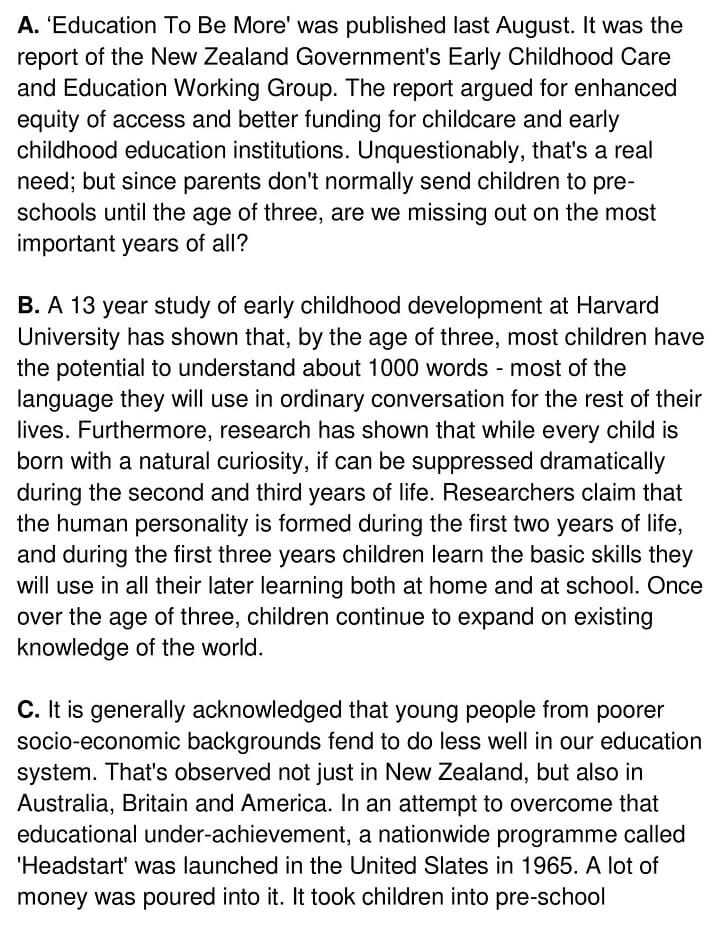
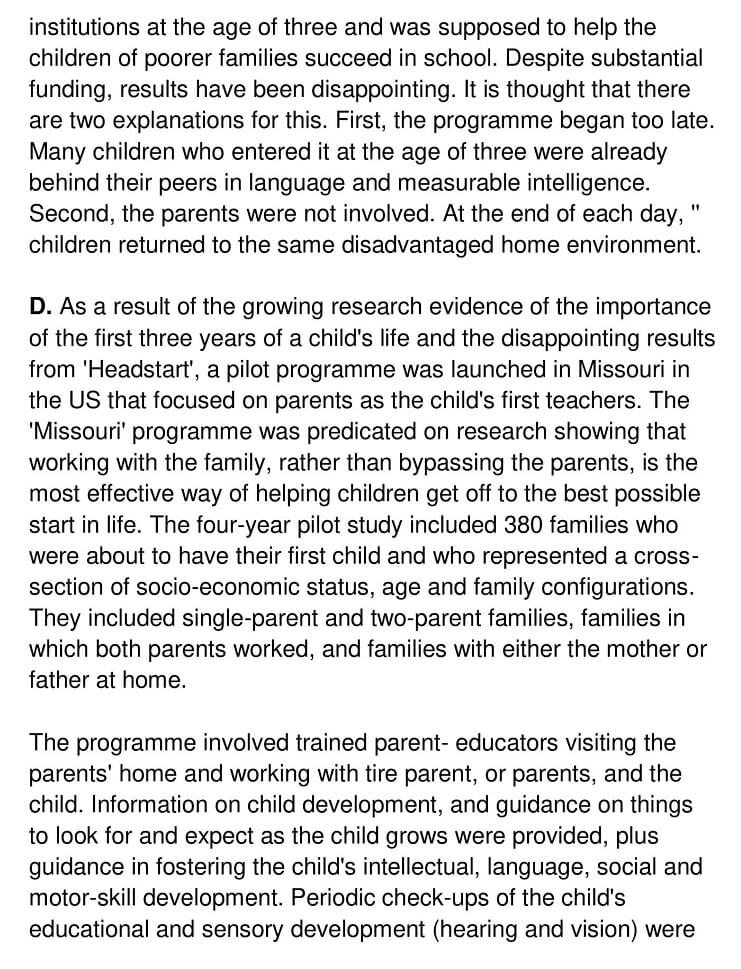
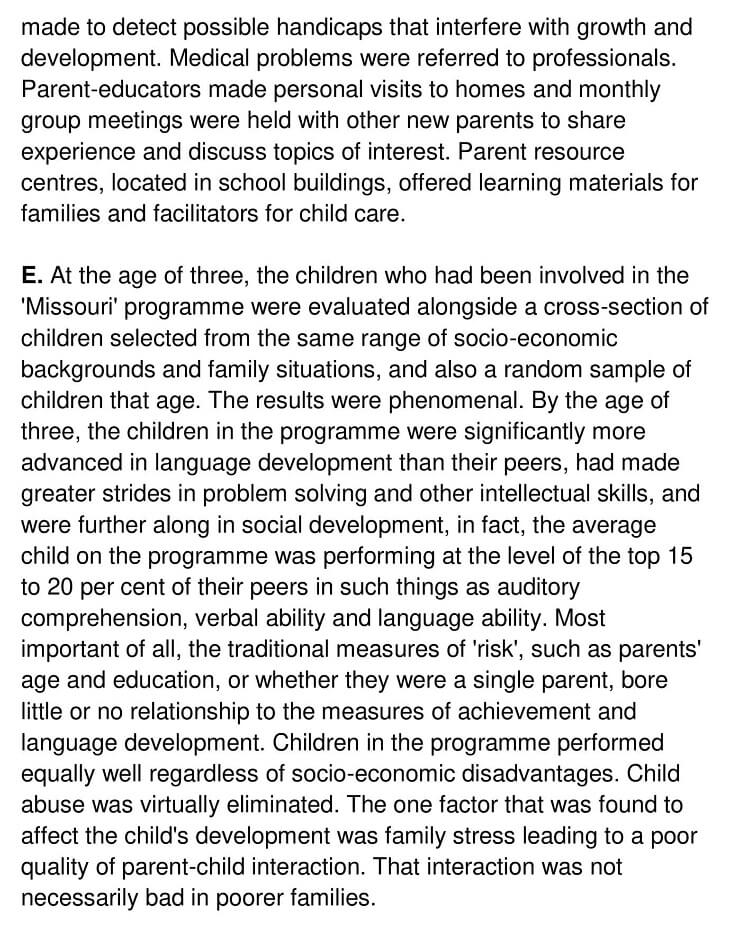
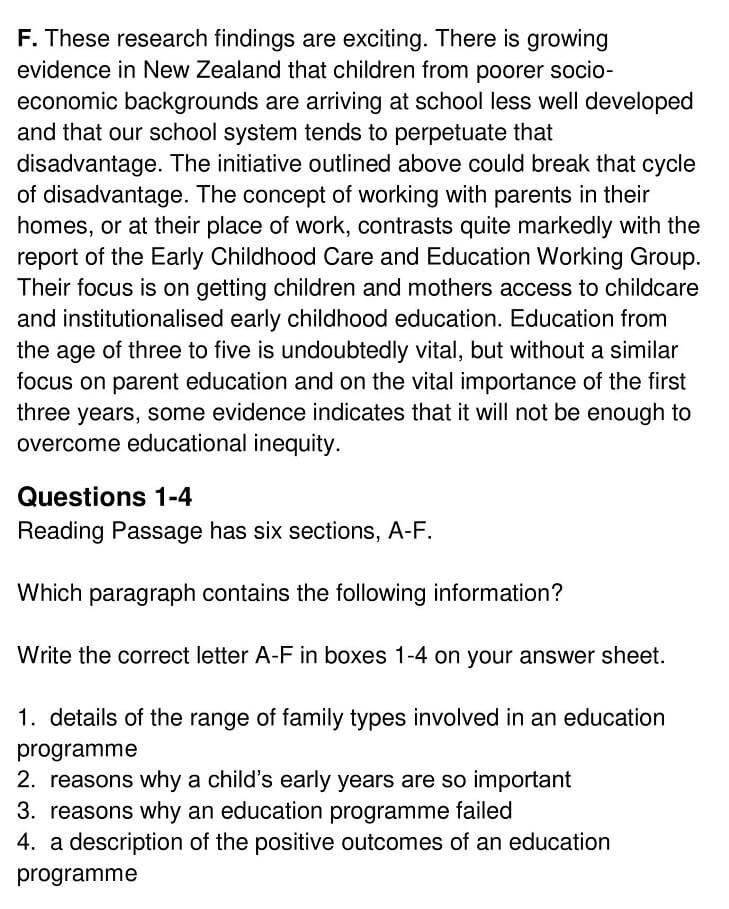
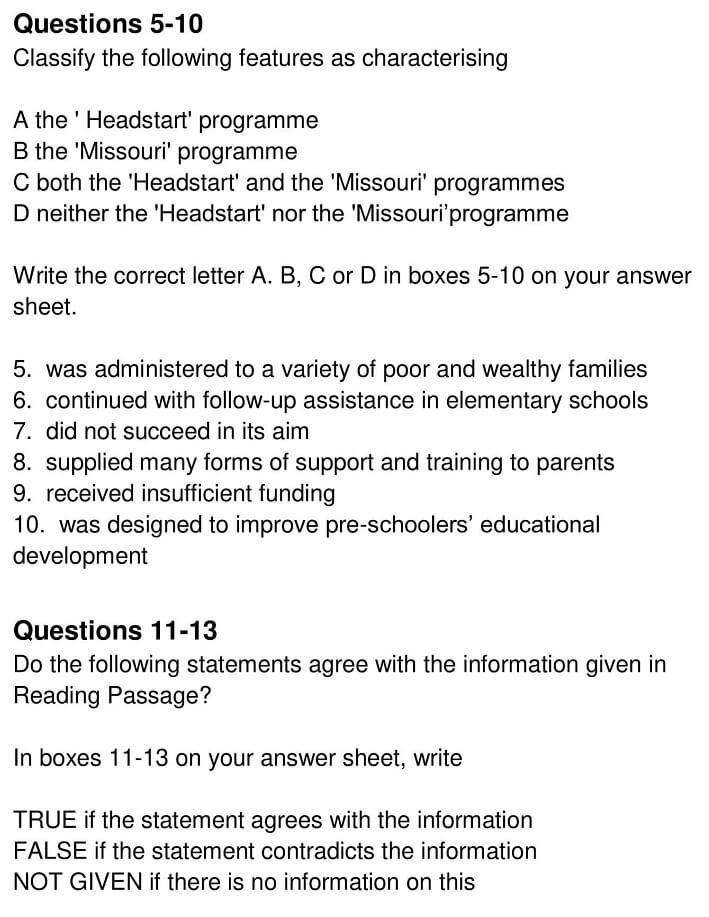
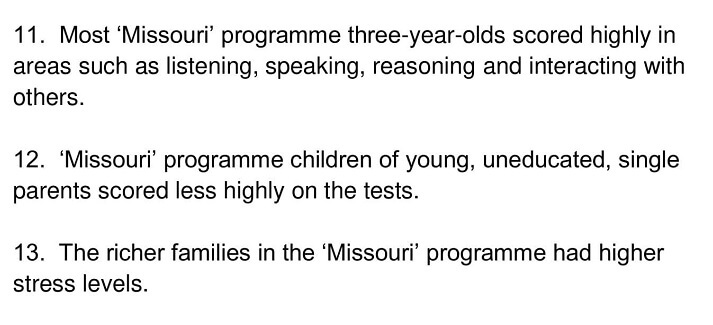
Answers
| Question number | Answer | Explanation |
|---|---|---|
| 1 | D | Paragraph D mentions that the ‘‘Missouri’ programme’ (education programme) was predicated on research showing that working with the family, rather than bypassing the parents, is the most effective way of helping children get off to the best possible start in life. The four-year pilot study included ‘380 families’ who were ‘about to have their first child’ and who ‘represented a cross-section of socio-economic status, age and family configurations’. They included ‘single-parent and two-parent families, families in which both parents worked, and families with either the mother or father at home’ (range of family types). Hence, the answer is D. |
| 2 | B | Paragraph B relates that a ‘13 year study of early childhood development at Harvard University’ has shown that, by the ‘age of three’, most children have the ‘potential to understand about 1000 words’. Furthermore, research has shown that while every child is born with a ‘natural curiosity’, it can be ‘suppressed dramatically during the second and third years of life’. Researchers claim that the ‘human personality is formed during the first two years of life’, and ‘during the first three years children learn the basic skills’ they will use in all their later learning both at home and at school. Hence, the answer is B. |
| 3 | C | In the first portion of paragraph C, it is stated that in an attempt to overcome that ‘educational under-achievement, a nationwide programme called ‘Headstart’’ was launched in the United Slates in 1965. A lot of money was poured into it. In the second portion of the same paragraph, it is added that despite substantial funding, ‘results have been disappointing’ (programme failed). It is thought that there are ‘two explanations’ for this (failure). ‘First, the programme began too late’. Many children who entered it at the age of three were already behind their peers in language and measurable intelligence. ‘Second, the parents were not involved’. At the end of each day, ” children returned to the same disadvantaged home environment. Hence, the answer is C. |
Unlock Answers
| 4 | E | Paragraph E informs that at the age of three, the children who had been involved in the ‘Missouri’ programme (educational programmes) were evaluated alongside a cross-section of children selected from the same range of socio-economic backgrounds and family situations, and also a random sample of children that age. The ‘results were phenomenal’ (positive outcome). By the age of three, the ‘children in the programme were significantly more advanced in language development than their peers’, had ‘made greater strides in problem solving and other intellectual skills’, and were ‘further along in social development’, in fact, the average child on the programme was performing at the level of the ‘top 15 to 20 per cent of their peers in such things as auditory comprehension, verbal ability and language ability’. Moreover, ‘children in the programme performed equally well regardless of socio-economic disadvantages’. ‘Child abuse was virtually eliminated’. Hence, the answer is E. |
| 5 | B | Paragraph D points out that ‘the ‘Missouri’ programme’ was predicated on research showing that working with the family, rather than bypassing the parents, is the most effective way of helping children get off to the best possible start in life. The four-year pilot study ‘included 380 families’ who were about to have their first child and who ‘represented a cross-section of socio-economic status’ (variety of poor and wealthy families), age and family configurations. Hence, the answer is B (the ‘Missouri’ programme). |
| 6 | D | In paragraph C, it is given that a ‘nationwide programme called ‘Headstart’ was launched’ in the United Slates in 1965. It took ‘children into pre-school institutions at the age of three’ (not elementary school) and was supposed to help the children of poorer families succeed in school. Paragraph D states that ‘a pilot programme was launched in Missouri’ in the US that focused on parents as the child’s first teachers. The ‘Missouri’ programme was predicated on research showing that working with the family, rather than bypassing the parents. Periodic check-ups of the child’s educational and sensory development (hearing and vision) were made to detect possible handicaps that interfere with growth and development. Medical problems were referred to professionals. Further, in paragraph E, it is mentioned that ‘at the age of three, the children’ (pre-schoolers) who had been involved in the ‘Missouri’ programme were evaluated. In the ‘Headstart’ programme, there is no specific mention of follow-up assistance. In the ‘Missouri’ programme, although there is a mention of lots of follow-up assistance, all of them are meant for preschoolers and their parents, not for elementary grades. Hence, the answer is D (neither the ‘Headstart’ and the ‘Missouri’ programmes). |
| 7 | A | Paragraph C notifies that in an attempt to overcome that educational under-achievement, a ‘nationwide programme called ‘Headstart’’ was launched in the United Slates in 1965. Despite substantial funding, ‘results have been disappointing’ (failed; did not succeed in its aim). Hence, the answer is A (the ‘Headstart’ programme). |
| 8 | B | Paragraph D tells about the ‘‘Missouri’ programme’ was predicated on research showing that working with the family, rather than bypassing the parents. The ‘programme involved trained parent- educators visiting the parents’ home’ and ‘working with tire parent, or parents’, and the child. ‘Information on child development, and guidance on things to look for and expect as the child grows were provided’, plus ‘guidance in fostering the child’s intellectual, language, social and motor-skill development’. ‘Parent-educators made personal visits to homes and monthly group meetings were held with other new parents’ to share experience and discuss topics of interest. ‘Parent resource centres, located in school buildings, offered learning materials for families and facilitators for child core’. Hence, the answer is B (the ‘Missouri’ programme). |
| 9 | D | Paragraph C relates that in an attempt to overcome that educational under-achievement, a ‘nationwide programme called ‘Headstart’’ was launched in the United Slates in 1965. ‘A lot of money was poured into it’. In Paragraph D, it is said that the ‘Missouri’ programme was predicated on research showing that working with the family, rather than bypassing the parents. The ‘programme involved trained parent- educators visiting the parents’ home and working with tire parent, or parents, and the child’. Moreover, in paragraph E, it is mentioned that the children who had been involved in the ‘Missouri’ programme were evaluated alongside a cross-section of children selected from the same range of socio-economic backgrounds and family situations, and also a random sample of children that age. The ‘results were phenomenal’. So, the number of facilities provided and the success of the programme proves that there was no lack of funds in the Missouri programme as well. Hence, the answer is D (neither the ‘Headstart’ and the ‘Missouri’ programmes). |
| 10 | C | Paragraph C brings out the fact that in an attempt to overcome that ‘educational under-achievement, a nationwide programme called ‘Headstart’’ was launched in the United Slates in 1965. It took ‘children into pre-school institutions’ (pre-schoolers) at the age of three and was supposed ‘to help the children of poorer families succeed in school’. In paragraph E, it is noted that At the ‘age of three’ (pre-schooler), the children who had been involved in the ‘Missouri’ programme were evaluated alongside a cross-section of children selected from the same range of socio-economic backgrounds and family situations, and also a random sample of children that age. Hence, the answer is C (both the ‘Headstart’ and the ‘Missouri’ programmes). |
| 11 | TRUE | In paragraph E, the writer writes that ‘the children who had been involved in the ‘Missouri’ programme were evaluated’ alongside a cross-section of children selected from the same range of socio-economic backgrounds and family situations, and also a random sample of children that age. By the age of three, the ‘children in the programme were significantly more advanced in language development’ than their peers, ‘had made greater strides in problem solving and other intellectual skills’ (reasoning), and were further along in social development, in fact, the average child on the programme was performing at the level of the top 15 to 20 percent of their peers in such things as ‘auditory comprehension’ (listening), ‘verbal ability’ (speaking) and ‘language ability’ (interacting with others). As the statement agrees with the information, the answer is ‘TRUE’. |
| 12 | FALSE | Paragraph E finds that at the age of three, the ‘children who had been involved in the ‘Missouri’ programme were evaluated’ alongside a cross-section of children selected from the same range of socio-economic backgrounds and family situations, and also a random sample of children that age. ‘Children in the programme performed equally’ well ‘regardless of socio-economic disadvantages’ (young, uneducated, single parents). As the information contradicts with the statement, the answer is ‘FALSE’. |
| 13 | NOT GIVEN | In paragraph E, it is told that the ‘one factor’ in the Missouri programme that was found to ‘affect the child’s development was family stress leading to a poor quality of parent-child interaction’. That interaction was not necessarily bad in poorer families. There is no mention whether the stress level was more in the rich family or the poor family. Hence, the answer is ‘NOT GIVEN’. |
Check More IELTS Reading Answers
Also check :
Practice IELTS Reading based on question types

Start Preparing for IELTS: Get Your 10-Day Study Plan Today!
Recent Articles

Nehasri Ravishenbagam

Haniya Yashfeen

Haniya Yashfeen

Haniya Yashfeen
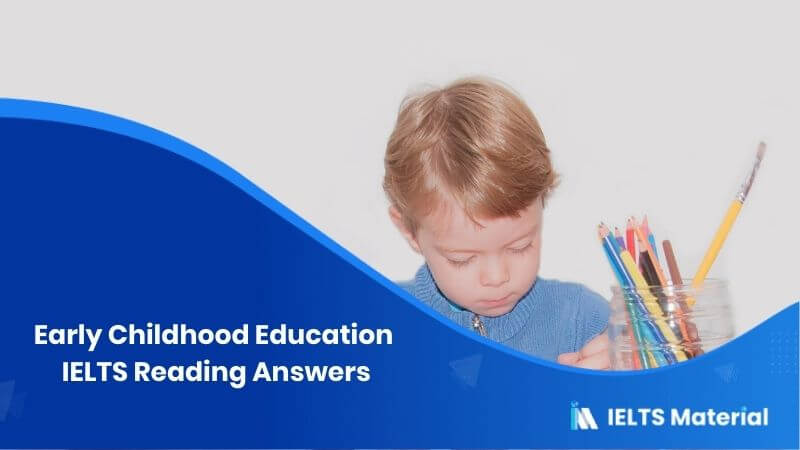



Post your Comments